Joint C3I Shows Skillz

No, the title of this post isn’t referring to a new rap group. Joint C3I stands for "Joint Command, Control, Communications and Intelligence," and Raytheon Company recently demonstrated its Joint Battlefield Integration capability with a "real-time hardware in-the-loop" demonstration of Joint C3I:
The… demonstration pushed required battlefield situational awareness to a new level by using existing and future communications infrastructures to enable real-time warfighter response at both strategic and tactical command levels. Using Raytheon’s Joint Fires (JFires) tool, which brings its own unique warfighting capability, commanders will now be able to view a single integrated picture by integrating tactical command and control with intelligence systems using satellite communications links. Open architecture and net-enabled products were key contributors bringing this capability forward….
The backbone technology that enables this capability is Raytheon’s TCN(R) (Tactical Component Network) software. Systems integrated for the demonstration included the U.S. Navy’s Zumwalt Total Ship Computing Environment, Raytheon’s JFires sensor networking environment, a satellite communications link, the U.S. Air Force’s Distributed Common Ground System, and Deep Siren, a submarine tactical paging system. Raytheon officials conducting the demonstration said that other sensor systems will also be integrated into Joint C3I.
Global connectivity is achieved using advanced extremely high frequency satellite communications with bandwidth to support video streaming, still images and intelligence, surveillance and reconnaissance data among geographically dispersed terminals.
Solypsis has a flash animation that gives you more information about one TCN (Tactical Component Network), while this document from the Navy Department Library explains the Navy’s view of network-centric warfare:
The concept of network-centric warfare (NCW) is a key element of the Department of Defense’s (DOD’s) transformation effort.1 NCW focuses on using computers, highspeed data links, and networking software to link military personnel, platforms, and formations into highly integrated local and wide-area networks. Within these networks, personnel will share large amounts of critical information on a rapid and continuous basis. DOD believes that NCW will dramatically improve combat capability and efficiency.
While we’re on the subject of the Navy, this weekend marks the 20th Navy Fleet Week in New York. Among the events (opens in PDF) are the chance to speak with developers of the latest Navy/Marine Corps technologies; the chance to take a virtual tour of a battle zone; and (this one we’re looking forward to) the opportunity learn to weld pipes in a virtual shipyard using the Office of Naval Research´s virtual reality training systems.
And who knows, learning to weld pipes might come in handy for our DIY Friday series.